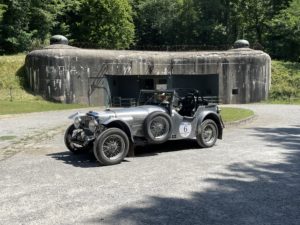In which Sid and Doris see the Maginot Line fort at Schoenenbourg, visit Verdun and then stay at Chateau Tilques before taking the Dover ferry as foot passengers.
 The Rhine crossing at Iffezheim is a major bit of 1970s civil engineering as the locks enable 100 barges a day to bypass the hydro-electric power station on the French side of the river. The difference in water height is very impressive. There may have been a panel but we missed it.
The Rhine crossing at Iffezheim is a major bit of 1970s civil engineering as the locks enable 100 barges a day to bypass the hydro-electric power station on the French side of the river. The difference in water height is very impressive. There may have been a panel but we missed it.
S and D have had a visit to the 1930s Maginot Line on the list for a long time. The line of forts ran from Italy to the North Sea, with lesser forts where the French border was with a neutral such as Switzerland.
The Belgians negotiated a reduction in the line on their border, feeling they would otherwise be sacrificed on the wrong side of the impervious fortification. There were also fewer forts in the hilly Ardennes where French generals expected German progress to be slow enough to give time for reinforcements to be brought up. Surprise!
The forts were planned and built during the 1930s (like the Alvis). One of the goals of the forts in this region was to protect Alsace Lorraine from invasion as the area had only been handed back to the French in 1918. The towns here look very like German towns.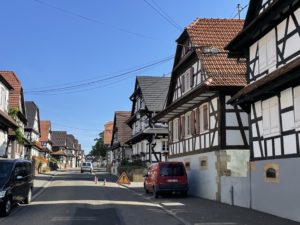
 S and D visited the Ouvrage at Schoenenbourg on a day of canicule, maybe 39 degrees. Twenty or thirty metres underground the temperature was a chilly twelve degrees, and very welcome.
S and D visited the Ouvrage at Schoenenbourg on a day of canicule, maybe 39 degrees. Twenty or thirty metres underground the temperature was a chilly twelve degrees, and very welcome.
The fort has five fighting turrets served by three kilometres of tunnels with the entrance for men and munitions about a kilometre behind the front line. Down below it has air conditioning, a power station (in case the grid has been knocked out), a telephone exchange, a garrison of over 600 with dormitories, kitchens and ablution zones all supporting the forward positions through rail tunnels and lift shafts. About 70 of the soldiers were engineers keeping the hydraulic turrets and lifts running.
The above ground munitions train is a diesel. In the tunnels the locomotives are electric, powered like trolley buses. The guns were 75mm, 47mm along with 81mm mortars and many turrets with twin machine guns. All around were smaller independent casemates with their own armament.
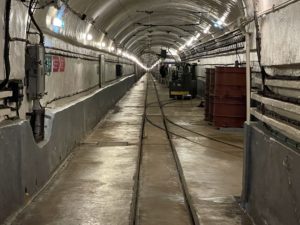 The fort has been sold to the local community and is operated by volunteers to bring visitors to local towns and businesses. An immense amount of work has gone into cleaning, painting and recommissioning. There are only two guides underground but there are panels in French, English and German. The old car is allowed to park in front of the Ouvrage.
The fort has been sold to the local community and is operated by volunteers to bring visitors to local towns and businesses. An immense amount of work has gone into cleaning, painting and recommissioning. There are only two guides underground but there are panels in French, English and German. The old car is allowed to park in front of the Ouvrage.
S and D stop in Verdun, but having visited the Ossuary just a few years back investigate the horror of that attritional battle no further. Instead they seek out a restaurant.
Monday night is shut night and the Italian that is open is run by a champion curmudgeon. Could we have some butter? No, nor can you have dipping oil or mustard. Could the next table have some mayo with their chips? No, it would all be much too expensive. Desolé.
On Tuesday morning the duo are mentally on a delivery drive to Calais, the ferry and home. At lunchtime the car delights the locals at a cafe as a salade de gesiers with Perrier menthe marks the last lunch of the tour.
Heading for St Omer and cruising in fifth gear on the A26 with the usual Brits-speeding-home there is a clanking noise. A look under the bonnet and some forward and reverse on the hard shoulder and it is soon clear the problem is, as expected, the gearbox. Fourth is still quiet. Pulling out into the traffic we find we are being shielded by a truck kindly running along behind the stricken Alvis. Doris finds a route to the Hotel Chateau Tilques away from the motorway while Sid uses fourth as far as possible, occasionally getting the rattle of lost teeth but generally continuing to make calm progress.
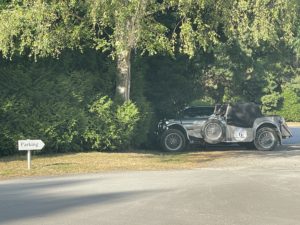 We park the boy in the shade and check in. Receptionist: ‘Our dining room is fully booked. Would you like me to give you details of local restaurants?’ Sid: ‘Non.’ Receptionist: ‘In the circumstances we could make an exception. 19.45?’ The receptionist also lets us leave the car for Alex to collect a few days later.
We park the boy in the shade and check in. Receptionist: ‘Our dining room is fully booked. Would you like me to give you details of local restaurants?’ Sid: ‘Non.’ Receptionist: ‘In the circumstances we could make an exception. 19.45?’ The receptionist also lets us leave the car for Alex to collect a few days later.
Doris completes the map on the bonnet and we organise what to leave with the car and what to schlep. As metropolitans with ready access to taxis and Ubers we leave the transport arrangements ‘til the morning.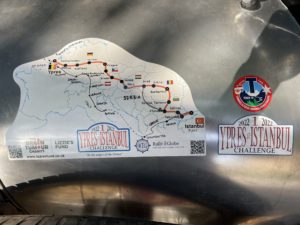
It is a time of congées. On Wednesday morning reception makes about two dozen calls to find Madame and her Citroen to take us to the Calais P&O foot passenger terminal. There is some waiting, but Sid has a Spad to enjoy.
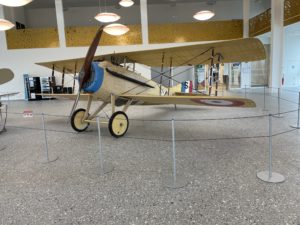 Then another hour of dozing/waiting. Once aboard, a brisk moving Doris claims seats at the front on the ferry. In Dover there is one taxi, but as fastest walkers we only need one (and share it with the runner up). At Dover Priory the train to Stratford International is late, which is great. Had it been on time we’d have missed it. And so, via the whole of the Westfield shopping centre and some train changes to the mojito shop and adventure HQ.
Then another hour of dozing/waiting. Once aboard, a brisk moving Doris claims seats at the front on the ferry. In Dover there is one taxi, but as fastest walkers we only need one (and share it with the runner up). At Dover Priory the train to Stratford International is late, which is great. Had it been on time we’d have missed it. And so, via the whole of the Westfield shopping centre and some train changes to the mojito shop and adventure HQ.
It was a grand adventure. We had the fun of RTG’s event, competitors, sweeps and gentils organisateurs. We met the guys at Ford Arad and had Jonathon’s company in Romania. We decided that with a ‘ran when parked’ gearbox it would be better not go via Albania. That choice was vindicated when we met Alessandro and Frank in Verona. Tackling the Timmelsjoch Pass after that might have been a ridge too far but how much of life can be spent in the valleys?
The summary. Leaving in a borrowed 1933 Alvis on 13th June 2,022 and getting home on 20th July covering 7,500 kilometres through England, France, Belgium, Germany, Czechia, Austria, Hungary, Romania, Serbia for the catch up drive, Bulgaria, Turkey, Greece, ferry, Italy, Austria, Germany, France using 1,300 litres of fuel, seven litres of oil, a tub of grease, a fire-crisped air filter, an extinguisher, a new Monit sensor and two gearboxes.
Fabulous route making and accommodation finding by Doris. Top mascoting by S, even though the suspension makes his eyes go boogly woogly when looking out for the trains. High paw, Silk. And Sid’s arms have stopped hurting.
